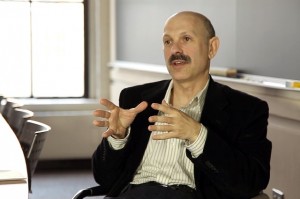Student Life in the Medieval Universities
Historian Peter Jones on the seven liberal arts, first textbooks and drinking as part of the student culture
The Panopticon is a famous building that appeared in the late 18th century, and it’s widely understood by historians as a prison design. So, in the past, prior to this period, the way that you punish people for crimes was through corporal punishment: you hurt them, and they won’t do it again. In the late 18th century, there was a movement to change that, to put people in prison instead, and the panopticon was a design for a building in which people would behave themselves. It consists of a circular building with cells all the way around the perimeter and a lodge in the centre for the inspector or the person who is in charge of the panopticon, in charge of the building. You put prisoners in the cells all around, and they can see the lodge that the inspector is located in. However, they don’t know whether the inspector is in the lodge or not. The inspector can always see them, so if they misbehave themselves, then the inspector can tell and come and get them, but they don’t know whether the inspector is there or not. And so the theory is that they’ll always behave themselves because it might be the case that the inspector is there even though they don’t know it.
There’s a famous example of this design being used as a metaphor for modern society by the French philosopher Michel Foucault. Foucault is actually just one of a lot of people who’ve written about the panopticon in recent years, but what Foucault said is that modern society is just like that.
Modern society is panoptic: it involves a situation where we behave ourselves because we never know whether we’re being watched or not, we’re being surveyed all the time by the police, by cameras on the streets, by forms and examinations, and so we’re caught in this visual web that makes us behave ourselves.
So that’s the panopticon, and that’s the bigger meaning that it has. And the question to ask or the question that interests me is where does the panopticon come from? The typical answer to that story is that it was designed by an English philosopher, jurist, and writer of the late 18th century called Jeremy Bentham. Bentham wrote a series of letters in answer to a competition for a prison design in the 1780s, and the panopticon was the thing that he came up with. What I have realized in my research is that actually, it wasn’t Jeremy Bentham who came up with the idea of the panopticon: it was his brother Samuel Bentham, and Samuel Bentham did it in the context of working for a Russian prince at the end of the 18th century who was called Grigory Potemkin.
The Panopticon is normally attributed to Jeremy Bentham, but I think you can’t understand the institution if you don’t realize that, in fact, it was the product of his brother, Samuel Bentham, and Jeremy says in the Panopticon letters that he wrote to describe it for the prison competition that it was an idea that he took from his brother. If you look at the Russian context in which the panopticon was designed, it’s apparent that originally, it actually had a quite different purpose to the one that’s normally associated with it of being a prisoner and of being this example of surveillance that’s in complete contrast to the old system of spectacular violence and corporal punishment.
So Potemkin had a large estate in that region, and he sent Samuel Bentham in the 1780s to go and develop the estate. The interesting question is what was Bentham actually supposed to do there. I would argue that he was supposed to create a kind of utopian production facility that would represent all the things that Potemkin had planned for the region: he set up a model dairy in a model farm and manufactories and shipbuilding facilities, and they were all supposed to work in a way that would be the future of Russian industry and enlightened estate management.
It’s in that context that Bentham planned to build a panopticon. He didn’t intend to use it as a prison; he wanted to use it as a manufactory. Normally, people have recognized that Samuel Bentham came up with this panopticon design originally, but what they said is that he used it to discipline his ‘ignorant Russian serfs’, and I think that’s a mistake because if you look in detail at the correspondence of Samuel (he wrote to Jeremy all the time, Jeremy was back in England), he actually says that the people who are a real problem for him are his English workers whom he imported over from England to do work and who were constantly causing chaos and getting drunk and being insubordinate. So I think the panopticon, insofar as it was a disciplinary institution, was designed to keep an eye on the English people who worked for Bentham.
The other thing that one needs to know about this is that Potemkin’s estate was part of the itinerary for a tour of the region that Potemkin arranged for Catherine the Great, Empress Catherine II, to make in 1786-1787. Bentham knew very well that Catherine was going to come and see the estate because he was asked to build a barge that she would use to go down the river as part of the tour.
So in fact, Bentham is designing this model, enlightened estate, specifically for the sovereign, for the empress to come and see, so the panopticon is our spectacle, the panopticon is a theatre, it’s a display of what a future Russian estate might look like and how power could be organized on it.
One of the things that I think is also interesting in that regard is that it reflects very much the way that Russian estates worked at the time. So, in England, if you were a landed gentleman with a house and servants, it was very important that you keep your servants invisible, and English houses at the time were designed so you couldn’t see the servants. On a Russian estate, however, the serfs were your wealth, and you put them on display so they were visible. There are traditions of serf theatre, and one makes a spectacle of them. And so what the panopticon did is it took the serfs on Potemkin’s estate, and it put them into a kind of theatre. In fact, theatricality is really interesting in Russia at this time: there’s a semiotician called Yuri Lotman who says that Russia at this time was all about theatricality and theatre and spectacle and that playing the foreigner was a key part of what any Russian noble did because being westernized, being Europeanized was something that Russians had only started to do really in the 18th century, and it became part of everyday life.
So what Bentham is offering here is a kind of space in which you form a microcosm of a Russian estate with your serfs visible from the central inspector’s lodge, and then inside the lodge, anyone can go in there, and they’re transformed from a traditional Russian nobleman into an enlightened Westerner. So, I think that one can read this institute in the panopticon through Lotman’s work and get quite interested in different views of it.
Why does this matter? First of all, I think it’s a very interesting context that gives rise to this very influential institution, and if we follow Foucault and other historians of the panopticon, it really informed the design of many different kinds of institutions, not just prisons but schools and hospitals and mad houses in the XIX century. But it also shows that there wasn’t a very strong distinction between the sovereign power of spectacle and display that Foucault talks about and the disciplinary surveillance power that he contrasts with in his famous book Discipline and Punish, which is where he talks about this culture of panopticism in modernity.
So I think that we have to rethink that division and understand that actually, there’s always an element of theatricality involved in this system of spectacle; surveillance can be a form of play, and I think that’s a key lesson of this story.

Historian Peter Jones on the seven liberal arts, first textbooks and drinking as part of the student culture

MIT Lecturer Vyacheslav Gerovitch on the idea of optimizing the Soviet economy with a computer network, the te...

MIT Prof. Loren Graham on biomedical ethics, challenges of becoming an academic discipline, and the impact of ...